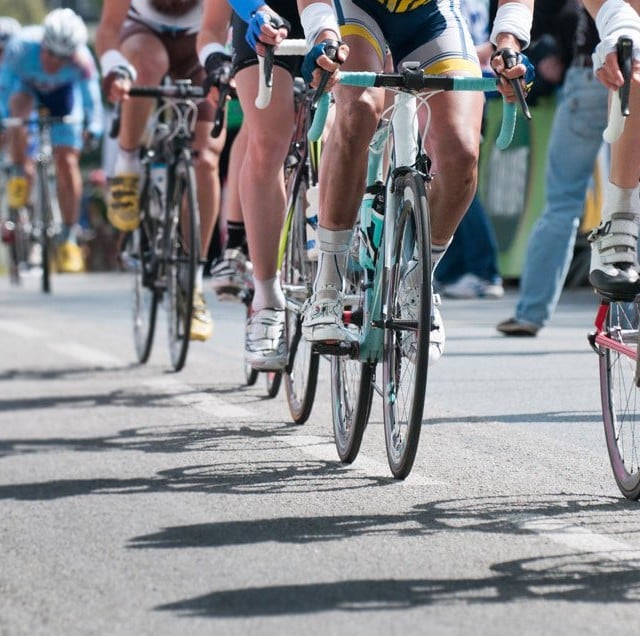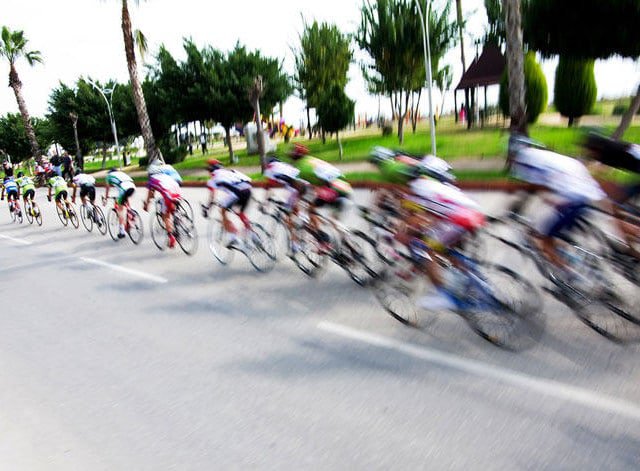How Drafting Can Make You Faster
Here's how to get the most out of drafting at any level.
Here’s how to get the most out of drafting at any level.

Drafting on a road bike feels a little like flying. It involves letting the rider in front of you block the wind, which creates an air pocket that virtually sucks you along, kind of like riding in the wake of a boat cruising through the water. It might sound silly, but in some cases, you can end up doing up to 30 percent less work just by following a wheel. Learning to draft also allows you to ride faster than you can alone—and it’s really fun. There are a few skills you need to master up front, but once you do, you’ll experience one of road cycling’s great joys.
The goal of drafting is to escape the wind, pure and simple. But that air pocket of protection will move, depending on the direction of the airflow. For example, in a headwind, the pocket will be directly behind the rider in front, so you can tuck in straight behind their back wheel; but in a cross wind (which comes at an angle from either side) you’ll need to move more to one side of the rider to take advantage of their body position. Just be cautious; drafting in a crosswind can be sketchy because it often requires overlapping the wheel in front of you, which can take you out if the rider ahead makes any sudden moves. “Any time you move to the side for a crosswind, you have to adjust your airbag to a side airbag,” says Dunlap.

It can be a bit mesmerizing to watch the hub in front of you spin while the road blurs. “If you’re staring only at the wheel in front of you and a crash happens ten riders up, your reaction is going to be a lot slower,” says Dunlap. She recommends constantly scanning: watch the wheel, check the leading rider’s body language, and look forward toward the front of the group to see what’s coming. “Part of being really good at drafting is reading what people are doing in front of you,” she says.
When you’ve mastered the group ride, you’ll eventually find yourself riding in a paceline, where a group of riders will all take turns “pulling” or riding at the front to share the effort of cutting the wind. To keep the group moving efficiently, it’s important to keep the pace steady when it’s your turn to “pull through” or ride at the front. It’s tempting to hammer as soon as you see open pavement ahead, but “you don’t want to surge,” cautions Dunlap. “You don’t want to be so hyper-excited that all of a sudden you’re going five or ten miles per hour faster than the group,” she says. “Everyone is going to hate you from behind.” So keep it steady when you pull through. And if you’re feeling extra good, take a longer pull on the front, rather than going faster, Dunlap says. Your buddies behind will definitely appreciate it!
If you’re struggling with cadence, one way to ramp up your leg speed is motor pacing or drafting behind a scooter, motorcycle, or an eBike. You’ll want an experienced partner to help you out with this one. Motorpacing is a great way to help you develop that dynamic pedal stroke you need to draft effectively, says Charles, who adds that you’ll engage different muscles to stay steady in a pack than you would riding alone. He says that the moto will “replace a really strong rider, giving you a sense of speed without tuckering out the rider who’s pulling you.” But he says you should choose your motorcar wisely. “They better be a cyclist, so they know what it feels like to increase the speed,” says Charles. Let the scooter do the work to help you get faster.

